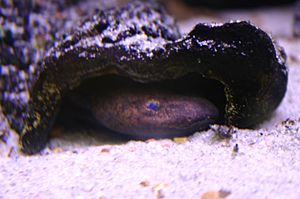Neuse River waterdog facts for kids
Quick facts for kids Neuse River waterdog |
|
|---|---|
 |
|
| Conservation status | |
| Scientific classification | |
| Genus: |
Necturus
|
| Species: |
lewisi
|
The Neuse River waterdog (scientific name: Necturus lewisi) is a medium-sized salamander that lives in water. It belongs to the Proteidae family. You can find it in two rivers in North Carolina.
Contents
Where It Lives
The Neuse River waterdog only lives in certain areas. Its home is limited to the Neuse and Tar-Pamlico River basins. These rivers are in the eastern Piedmont and Coastal Plain regions of North Carolina.
Appearance and Body
The Neuse River waterdog has a rusty-brown back with many large, bluish-black spots. Its belly is dark brown to gray and also has spots. The front of its head is flat and blunt. Its tail is flat on the sides and has a ridge. Each back leg has four toes. The gills are dull red and look bushy.
Adult males and females are about the same size. They measure from 16.5 to 28.0 centimeters (about 6.5 to 11 inches) from their snout to the tip of their tail. Young waterdogs have a dark stripe along their back and a dark stripe along their sides.
Males become ready to reproduce when they are about 5.5 years old. Females are ready when they are about 6.5 years old. This happens when they reach a certain body length.
Habitat
Neuse River waterdogs like streams that flow faster than 10 centimeters (4 inches) per second. They prefer streams that are wider than 15 meters (50 feet) and deeper than 1 meter (3 feet). They like areas with hard clay or soil at the bottom, or places covered with fallen leaves.
Young waterdogs are found in leaf beds in calmer waters. These leaf beds offer them places to hide and find food. Male waterdogs tend to move around more than females. Both males and females move more after small rains. However, they move less after very heavy rains (more than 40 millimeters or 1.5 inches).
During winter, adult waterdogs mostly stay in burrows in riverbanks or under large rocks. In spring, they move to big rock areas or under large boulders where the water flows faster. This is where they build their nests. Their home areas often include animal burrows, rock overhangs, or flat rocks on sandy or gravelly bottoms. They also like calm areas with mats of leaves and other plant bits.
Adults make hiding spots by pushing sand and gravel with their snouts. This creates a space under rocks or other objects. Sometimes, they pick up gravel in their mouths and move it away from their hiding spot. The entrance to these spots usually faces downstream.
Females, and sometimes males, will protect their hiding spots from other waterdogs. They show they are upset by flaring and pulsing their gills, and by curling their upper lip. If another waterdog doesn't leave after this warning, the waterdog will attack and bite it, usually on the tail.
Reproduction and Life Cycle
Male waterdogs have sperm from November through May. Females have been found with this sperm from December through May. Females move to nesting spots under fast-moving water during the spring. They lay their eggs in April and May. This is when their eggs are at their largest size. The eggs are 8–9 millimeters (about 0.3 inches) wide. They attach to the river bottom with a blunt stalk.
Courtship
When a pair of Neuse River waterdogs are ready to mate, they crawl slowly. The male follows the female closely, about 2–4 centimeters (1-2 inches) behind her. When the female stops, the male puts his snout behind her back legs. The female will have her gills flared out, while the male keeps his close to his neck.
Then, the male moves over her body near the base of her tail. Once they are side-by-side, the male starts to gently rub the female with his chin. He starts at her head, moves about halfway down her body, and then back to her head. The female lifts her head each time the male's chin touches her neck or head. This goes on many times for about 18 minutes.
After this, the male circles the female in a clockwise direction, always touching her. After several slow circles, the male moves next to the female and places his limbs over her back. The pair stays in this position for about 30 minutes before moving away.
Diet and Feeding
Adult waterdogs eat from the entrance of their hiding spots. They also move around at night to find food. They use their sense of smell and sight to find prey. These animals are active away from their hiding spots at night. They are also active when water levels are high and the water is cloudy. They become inactive when the stream temperature goes above 18 °C (64 °F).
Adults mainly hunt and eat snails, earthworms, isopods, amphipods, mayflies, stoneflies, caddisflies, true flies, and small fish. They also eat slugs, leeches, spiders, crayfish, centipedes, millipedes, odonates (like dragonflies), hellgrammites, beetles, caterpillars, and other salamanders.
Young waterdogs (larvae) mainly eat tiny creatures like ostracods, copepods, mayflies, true flies, and beetles. They also eat earthworms, other small crustaceans, isopods, amphipods, springtails, odonates, and stoneflies, along with other insects.
Predators
Neuse River waterdogs are mainly hunted by fish. To protect themselves, they produce special chemicals that can warn off these predators.
- Petranka, James W. (1998) Salamanders of the United States and Canada, Washington and London: Smithsonian Institution Press.


